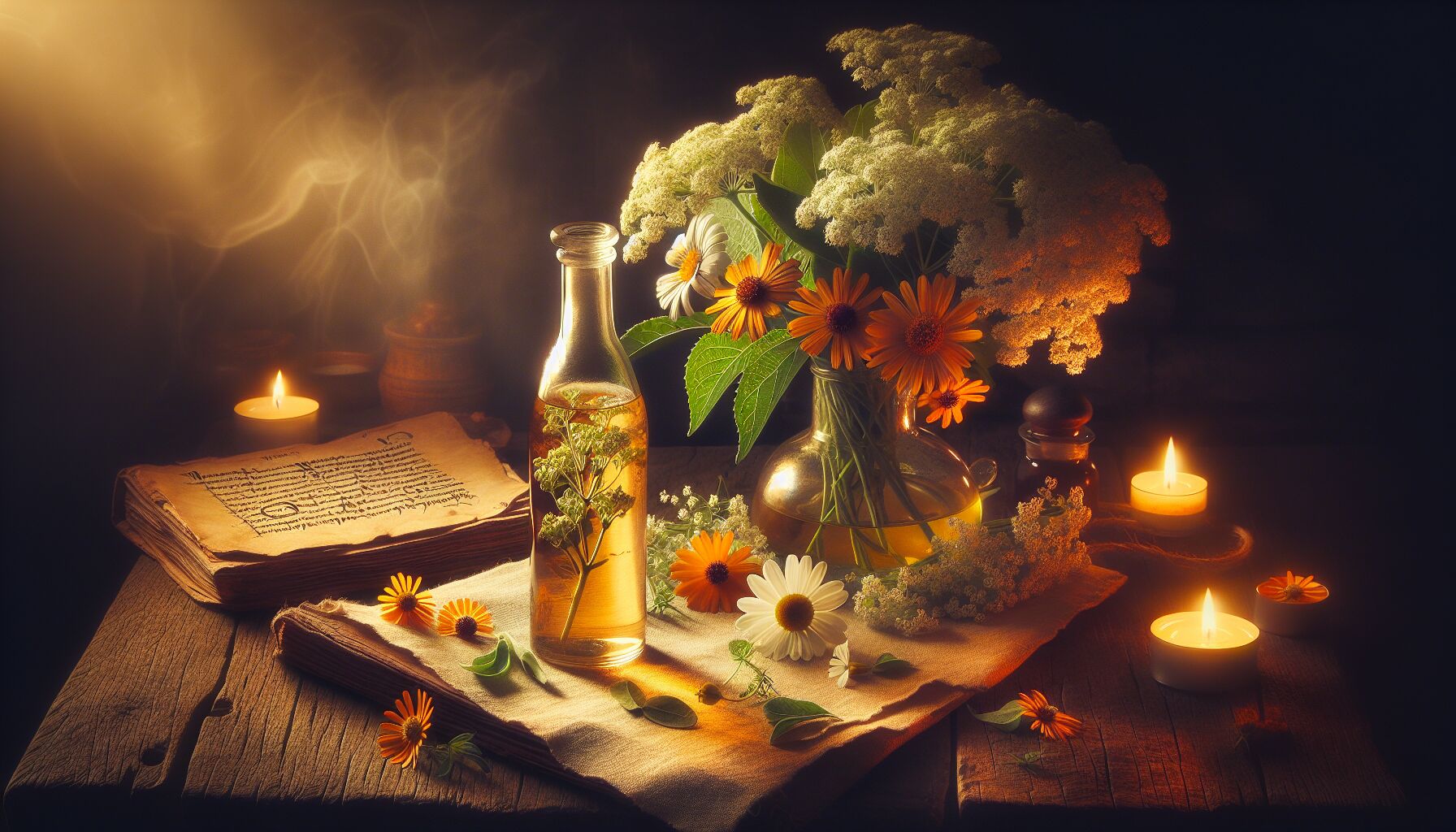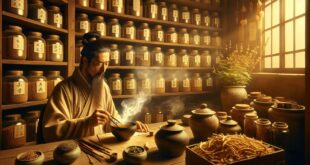 Some of what we now call medieval remedies weren’t just guesses dressed in superstition—they were careful, time-tested concoctions made by observing nature’s patterns and tuning in to what the human body truly needs. Monastic gardens, village stillrooms, and traveling herb-sellers once formed the backbone of folk medicine in Europe, passing along recipes that helped people heal when the closest physician was days away, or nonexistent. These weren’t casual brews tossed together—they were sacred in their own way, often prepared with intention, patience, and a reverence for life that’s mostly missing in modern over-the-counter aisles.
Some of what we now call medieval remedies weren’t just guesses dressed in superstition—they were careful, time-tested concoctions made by observing nature’s patterns and tuning in to what the human body truly needs. Monastic gardens, village stillrooms, and traveling herb-sellers once formed the backbone of folk medicine in Europe, passing along recipes that helped people heal when the closest physician was days away, or nonexistent. These weren’t casual brews tossed together—they were sacred in their own way, often prepared with intention, patience, and a reverence for life that’s mostly missing in modern over-the-counter aisles.
Let’s get one thing straight—these medieval herbal tonics weren’t miracle cures, and they weren’t pretending to be. They were part of a slower kind of healing, one that required presence, commitment, and an honest relationship with the body. That said, many of these old tonic recipes show surprising levels of sophistication. Some even anticipated what we now understand through modern pharmacology: compounds that fight infections, ease inflammation, and support what we’d call immune boosters today.
“Observe the nature of things deeply, and they will teach you the remedy,” wrote Hildegard of Bingen, a 12th-century abbess and herbalist.
Take oxymel, for instance. That tangy blend of honey and vinegar wasn’t just a flavor fix—it was an intelligent carrier for herbs like thyme, garlic, or hyssop. The vinegar drew out mineral content; the honey preserved the mix and made it palatable. This tonic was used for persistent coughs, digestive sluggishness, and even infection recovery. Sip a tablespoon today, and you can feel it stir the blood. And no, that’s not your imagination—it’s circulation boosting, thanks to compounds like allicin and thymol.
Then there’s the legendary theriac. Originally concocted in ancient Greece but fine-tuned by medieval apothecaries, theriac was once considered the ultimate panacea—containing as many as 60 herbs, resins, and exotic elements like myrrh, saffron, and even viper flesh. While overblown in reputation (some claimed it could cure plague or bring back lost youth), a trimmed-down version of theriac still carries potential. Warming herbs, blood movers, and bitter roots make it a compelling formula for infections and imbalanced digestion. Scientists now understand bitter plants like gentian and angelica actually stimulate digestive enzymes and bile flow—things our ancestors somehow already knew, without an endoscope or lab report.
“Modern medicine owes much to the herbs and roots once gathered in twilight,” wrote ethnobotanist Richard Evans Schultes.
And speaking of bitters… Medieval apothecaries often prepared wine-based bitters not for drunkenness, but for vitality—especially during colder months when foods were heavier and illness lingered. These immune boosters weren’t just about physical immunity—they supported what monks of the time called the “humors” or internal balance. You’ve likely felt something similar on your own—when your body feels fogged, heavy, resistant to flow. Those bitters, now echoing in modern ‘digestif’ drinks, helped to restore clarity from the inside.
Not all these lost remedies were liquid either. Apothecary rooms saw powders like galangal-laced electuaries or spiced honey-pills pressed into wax paper for travelers. They were portable medicine, made to be stored for months and taken when the body started to misfire or the spirit began to wear thin. Some of these remedies contained adaptogenic herbs—though they didn’t use that word—like ashwagandha’s European cousin, withania. It’s funny how long it took us to circle back.
Let me explain something that’s easy to overlook: the making of these tonics wasn’t separate from life—it was life. Farmers, mothers, monks, blacksmiths—they were all medicine keepers in their own right. The rhythm of stirring a pot over fire, the scent of elderberry and sage bundled together, these things were teachings, not just treatments. And in that way, each healing tonic doubled as a kind of prayer. Not the airy kind—but rooted devotion to care, attention, and natural wisdom.
As the cold season rolls in, there’s something grounding—almost ancestral—about brewing a spiced cordial from dried herbs or simmering a decoction of roots. It’s not about escaping illness, but rather creating space for resilience. Many of these medieval remedies, when brought back with care and modern context, still deliver. Not because they’re trendy, but because the body remembers.
Here’s the thing: this knowledge was never lost. It was just set aside. Hidden behind sterile packaging and synthetic fixes. Dig just a little—into family journals, dusty herbals, survival books—and you’ll start uncovering recipes that still whisper with genius.
Which raises the real question: what else did they know that we’ve forgotten?
Herbal remedies backed by modern science
There’s something oddly satisfying about seeing modern science catch up to common sense—and that’s exactly what’s happening with many of these so-called “medieval remedies.” Once dismissed as quaint folklore or superstition by the medical establishment, herbal tonics are now under the microscope, and the results? Well, they’re making a lot of lab coats look a little sheepish.
Let’s start with one that’s made quite the comeback: elderberry syrup. In medieval Europe, elder—Sambucus nigra—was considered sacred, often planted near homesteads for both protection and winter medicine. Turns out, science agrees. Clinical trials published on NCBI show elderberry can significantly reduce the duration and severity of influenza symptoms. Not bad for something you can make at home with little more than a pot, some dried berries, and raw honey.
And it’s not just elder. Modern studies are consistently confirming the efficacy of herbs that grandmothers and monks swore by. Take yarrow, or Achillea millefolium. It was a battlefield plant used to staunch wounds—hence its nickname “soldier’s woundwort.” But it wasn’t just military-grade first aid. Yarrow is now studied for its anti-inflammatory and antimicrobial properties, making it a solid choice for colds, fevers, and gut tension. Not to mention, it makes a fine tea that brings a surprising clarity in both body and mind when you’re under the weather.
“The part can never be well unless the whole is well.” — Plato. That applies here too. When the body’s communication system is intact—immune, gut, lymph, nervous—it tends to take care of business on its own.
Here’s something else worth paying attention to: medieval herbalists often brewed tonics not for quick fixes, but for gentle, repeated support. That’s what makes formulas like fire cider so powerful. It didn’t just pop out of a trendy wellness cookbook—its roots are deep and weathered. Apple cider vinegar, horseradish, garlic, onion, ginger, cayenne—ingredients that were known to keep people sharp through damp winters and plague seasons. Today, herbalists—from Appalachian grannies to integrative MDs—use fire cider as one of nature’s more aggressive immune boosters. And it works. The National Institute of Health has multiple listings of the active compounds in garlic and ginger showing antimicrobial, antiviral, and circulatory support capabilities.
Why does this matter? Because we’ve normalized numbness. We reach for isolated compounds—ibuprofen, antihistamines, antibiotics—while ignoring the systems they disrupt. But the old remedies? They supported systems. They nourished. And they did it gently.
Consider hawthorn. In medieval Europe, this thorned hedge plant was a symbol of protection—both spiritual and cardiovascular. Today, we understand hawthorn as a cardiotonic; it improves blood flow, reduces anxiety, and strengthens heart contractions. That’s not hippie nonsense; studies from institutions across Europe have supported its effectiveness, especially for early-stage heart disease. You think the monks at Chartres had blood pressure monitors? No—but they were watchers of patterns, listeners of breath, readers of the pulse.
“To treat the illness without treating the environment in which it arose is a half-measure,” said Virchow, the father of cellular pathology.
That brings us to bitters again—a realm where medieval wisdom really shines. These blends weren’t just digestive tools, they were regulators of mood and energy. Plants like gentian root, wormwood, and angelica narrow the window of glucose flooding, promote nutrient absorption, and reduce microbial imbalance in the gut. Which is big—because the microbiome, we now know, plays a starring role in immune function, mental health, and even hormone regulation. You don’t need to isolate the psychobiotic strain when a thoughtfully layered bitter formula gets the terrain right.
Let me be clear—no one’s saying to toss your entire medicine cabinet into the compost bin. But maybe… just maybe, keep a section for medicine that comes from soil instead of a shelf. Even something as simple as infusing nettle with lemon balm can offer a mineral-rich daily tonic that gently restores depleted adrenals while calming the edges of a restless mind.
Here’s something to chew on: medieval medicine wasn’t “alternative.” It was primary care. Field care. Spiritual care. And much of it, as we’re now discovering, was grounded in real biochemistry. The challenge, really, is cultural. We’ve got decades of marketing built on speed and separation—quick relief, isolated symptoms, things in neat white containers with expiration dates stamped like dogma. But that’s not how life moves.
Real immune boosters engage the body’s own intelligence. And as research intersects with tradition, the overlap grows more obvious. Tulsi (holy basil) controls blood sugar and supports respiratory inflammation. Licorice root acts as a mild antiviral with cortisol-supporting benefits. Reishi mushrooms regulate cytokine response—a fancy way of saying they soften the blow when the immune system’s freaking out. All of these show up, again and again, tucked between the pages of old herbals and in the formula notes of quiet mountain rootworkers.
You’ve probably noticed that genuine healing doesn’t rush you—it invites you. The same way a good tonic doesn’t blast your body—it strengthens your reserves, slow and steady.
So if you ever find the old ways calling you—via an unexpectedly strong cup of mint tea or a memory of your grandmother’s ginger brew—that’s not nostalgia. That’s your lineage humming. Maybe now’s the time to listen.
Elixirs worth rediscovering today
 Some of the most practical herbal tonics we could bring back into daily life aren’t locked away in vaults or only found in high-priced apothecaries—they’re already growing wild, tucked in kitchen pantries, or sitting quietly on co-op shelves. What these herbal elixirs offer is more than mere symptom-chasing—they work with the body like a seasoned dance partner, not a whistle-blowing coach. And that matters, especially when we’re looking for long-term resilience instead of short-term silencing.
Some of the most practical herbal tonics we could bring back into daily life aren’t locked away in vaults or only found in high-priced apothecaries—they’re already growing wild, tucked in kitchen pantries, or sitting quietly on co-op shelves. What these herbal elixirs offer is more than mere symptom-chasing—they work with the body like a seasoned dance partner, not a whistle-blowing coach. And that matters, especially when we’re looking for long-term resilience instead of short-term silencing.
Let’s bring cordials back—not in the sugary, fluorescent way, but in their original form: strengthening herbal brews preserved in honey or wine. Try mixing elderflower, calendula, and a splash of meadowsweet into a deeply golden syrup. Sip it during allergy season or after a long stretch of stress. Each herb has real data behind it—anti-inflammatory, lymph-moving, mood-supportive—and yet when they’re prepared with intention as a cordial, the effect becomes more than chemical. It becomes restorative. Almost like breathing in again after holding your breath too long.
“Nature does not hurry, yet everything is accomplished.” — Lao Tzu
There’s practicality in that insight. No good elixir rushes in and takes over. It nudges. It reminds the immune system, “Hey… you’ve got this.” That’s the foundational intelligence behind medieval remedies—coexistence and cooperation. Take a warming tonic like garlic wine: a simple maceration of chopped garlic in dry red wine left for a week in a cool, dark spot. Sounds rustic, yes, but pharmacologically it makes sense. The ethanol pulls allicin from the garlic, which is antimicrobial, circulatory, and a bit provocative to the senses—in a good way. That stimulation is the point. It gets things moving. In traditional European medicine, stagnation equals illness. Keep the blood and breath circulating, and you keep the system *aware*.
If respiratory resilience is what you’re after, few elixirs meet the moment like a hyssop-honey glycerite. A glycerite is the gentler cousin to tincture-making—glycerin instead of alcohol—which makes it suitable for kids or the alcohol-sensitive. Add lemon balm, wild cherry bark, and hyssop flowers, and you’ve got an immune booster that sings through sore winters. It soothes, breaks up congestion, and supports gentle antiviral action, all while tasting like a memory you didn’t know you had.
And then there’s tonic vinegar—also called herbal oxymels when honey’s involved (like we mentioned earlier). Make no mistake, this isn’t trendy salad dressing rebranded. Raw apple cider vinegar is potent all on its own—full of living enzymes and trace minerals. When paired with things like rosemary, sage, and red clover, you get something deeply cleansing for the lymph and liver. Ideal for transitional times like spring or fall—the body’s natural “reset” seasons. Folks forget that immunity isn’t just about avoiding colds. It’s the full functionality of elimination, digestion, repair. If you’re always tired, foggy, or emotionally flat, that could be your “immunity” hollering for support—not just your white blood cell count.
- Fire cider for seasonal defense: balancing pungents like horseradish and raw garlic with sweet roots like burdock and ginger
- Herb-infused broths: nettle, astragalus, and shiitake simmered into savory bases—tonics disguised as comfort food
- Medicinal wines: infused red or white wine with hawthorn, rose hips, or even motherwort for subtle cardiovascular and emotional support
Notice the rhythm here? These aren’t “take a dropper and be done” remedies. They ask you to participate—to stir, to steep, to taste with attention. Even that act of slowing down while making a batch of rose petal elixir or steeping turmeric-and-black-pepper golden milk can change your breath pattern, lower cortisol, and shift how you carry your day. It’s hard to find a pharmaceutical with those side benefits.
Sometimes, the healing isn’t just in the ingestion—it’s in the reconnecting. Many of these medieval remedies were communal: shared in villages, prepared in groups, stored in crocks during long winters. Especially now, with chronic isolation quietly eating away at collective well-being, reintroducing these practices is no small thing. Making herbal tonics together, even over a Zoom chat or a backyard potluck, brings something forgotten back into our healing narrative—relationship.
“When we heal the earth, we heal ourselves.” — David Orr, environmental educator. When we touch the land, taste its medicine, and remember its flavor, health becomes less of a goal and more of a rhythm.
One more? Try simmering roots and bark into an evening elixir—like a decoction of ashwagandha, cinnamon, and dandelion root. It’s slightly bitter, slightly sweet, deeply grounding. Even if you don’t think it’s “doing much,” check your nervous system twenty minutes later. The steadiness is unmistakable. These kinds of immune boosters don’t shout—they whisper in.
What makes these worth rediscovering today isn’t just nostalgia or novelty—it’s function. When digital life frays the nerves, when the simplest cold derails your week, when your energy dips so low you forget what “well” feels like… these old ways aren’t fads. They’re scaffolding. They’re reminders.
We don’t need to rebuild medieval medicine. But patching the good pieces back into our daily lives? That’s just good sense. And honestly, your body already knows what to do with pine-needle syrup, elderberry cordial, or catnip tincture—it’s just waiting for you to remember.
 DS Haven In Light Of Things
DS Haven In Light Of Things






